Author: Tammara Wood
Photography: Lars Blackmore, www.ameridane.org

The Center for Quantitative Biology and members of its External Advisory Committee (EAC) gathered Wednesday, April 6th at the Hanover Inn to review the progress of the CQB COBRE grant and share research updates. Attendees included CQB investigators, mentors, leadership, and staff, as well as members of the EAC.
CQB Director, Dr. Mike Whitfield, opened the event with a Center overview, highlighting the successful graduation of two project leaders, Drs. Matt Mahoney and Feng Fu, and the addition of two new research project leads, Drs. Siming Zhao and Britt Goods, as well as the active COBRE faculty search ongoing in the Department of Biomedical Data Science. The CQB also contributed to a faculty recruitment in Molecular & Systems Biology. Dr. Whitfield then turned the floor over to a series of CQB Project Leaders to present their ongoing research.
Project Leader Presentations
“Gene set testing for single-cell data”
Project Leader: Robert Frost
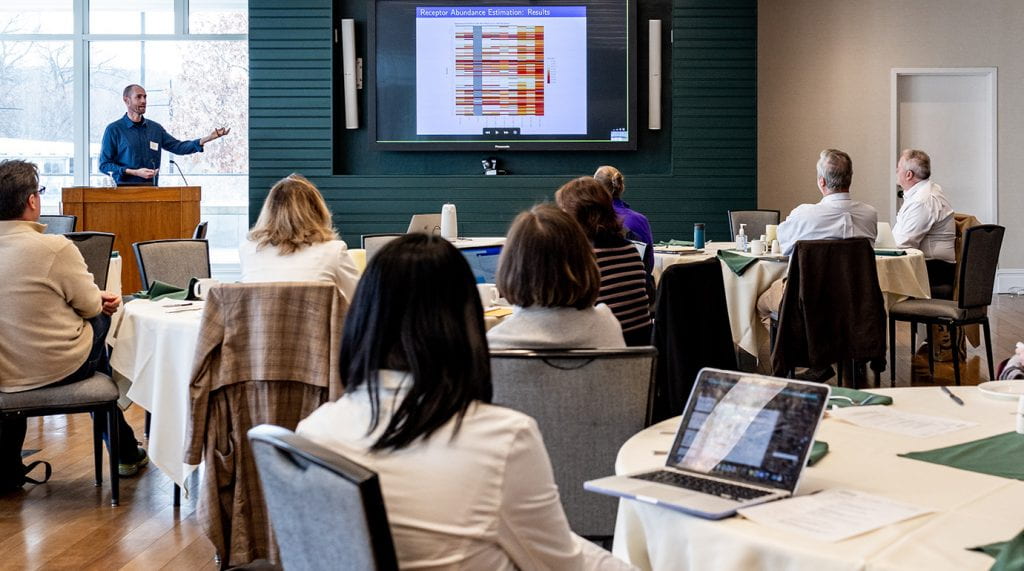
Dr. Frost presented an overview of single cell genomic profiling. He provided solutions and rationale to addressing limitations to this type of data which segued nicely into the progress made on Aim 1 and 2 of his CQB research project. His presentation described several student led projects that grew from these Aims; Multi-label cell typing based on empirical data and expert knowledge, accurate estimation of protein abundance for receptors with or without antibody data, and a method for single sample scoring of taxonomic sets using microbiome relative abundance data.
“Computational approaches to studying somatic mutations in cancer”
Project Leader: Siming Zhao
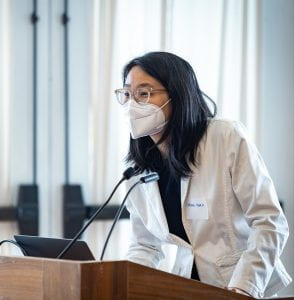
Dr. Siming Zhao, who joined the CQB in July 2021, provided an overview of her project focusing on estimating selection pressure by finding the deviation of mutation rate compared to the background rate, before opening the floor up to questions and suggestions from the audience.
“Gene regulation and dynamical efficacy in antibiotic responses”
Project Leader: Daniel Schultz
Dr. Schultz provided an overview of predicting the evolution of antibiotic resistance. He showed regulation of the E. coli tetracycline resistance tet operon evolves in complex environments and can be lost in fast-changing drug regimens. He presented data on how induction of the wild type mexXYZ multidrug resistance mechanism in P. aeruginosa is slow, but once in the lung it acquires mutations to speed up the response. He also showed how, by understanding the effect of regulatory pathways in the resistance phenotypes of microbes, we can devise treatment regimens that address specific drug-resistance profiles.
“Histological imaging genetics of aging kidney morphology in Diversity Outbred mice”
COBRE Graduate: Matt Mahoney

Dr. Mahoney presented on his recently funded R01 project, graduating him from the COBRE. The work involves deep learning segmentation and quantification of kidney tissue. This work uses neural networks to compute “black box” numerical signatures of the variability of kidney tissue across genetically diverse mice. Using these numerical signatures, GWAS is performed to identify genetic loci driving structural variation in tissue and image montages are used to interpret these “black box” features. Next for Dr. Mahoney is ordering CRISPR strains to validate these associations, extending this approach to other tissues, and extending these techniques to include transcriptomic, proteomic, and physiological data.
“Mathematical and in-silico models of cancer cell dynamics for personalized immunotherapy”
Project Leader: Feng Fu
Dr. Fu’s research plan focuses on a very important issue in the development of combination immunotherapy. He provided an overview of his project which included biomedical data-driven modeling. He will be wrapping up this COBRE project by the end of June and will rotate off July 1, 2022.
Pilot Project Presentations
All three pilot projects provided an overview of their currently funded projects.

Dr. Patricia Pioli discussed pandemic-related limitations on her ability to acquire necessary materials for her originally proposed studies. As a result, her project pivoted in a new direction. These studies, which focus on inhibiting the development of acquired therapeutic resistance to melanoma inhibitors, were presented in Overcoming Immune Suppression in the Melanoma Tumor Microenvironment (TME). Using a synthetic compound (CDDO-Me), she has shown that resistance is impeded through remodeling of immune activation in the melanoma TME. Her current goals are to elucidate the molecular mechanism by which CDDO-Me alters myeloid activation based on pathway analysis of scRNA-seq data. Future studies will investigate therapeutic efficacy of combination with immune checkpoint inhibitors.
Dr. Diwakar R. Pattabiraman presented his work on understanding the heterogeneity of responses to chemotherapy. He showed the use of DNA Barcodes to map cellular systems and to understand cellular dynamics in response to chemotherapy. From this he has uncovered a specific trajectory that cells take upon treatment with eribulin to undergo mesenchymal-to-epithelial transition. His current goals are to continue this work in vivo.
Dr. Sladjana Skopelja-Gardner’s project, Mechanisms of kidney inflammation and Injury in Lupus Photosensitivity, has the overall goal of identifying targetable pathways that specifically address how sensitivity to ultraviolet sunlight rays, a feature common to most lupus patients, leads to kidney disease (lupus nephritis, LN). She provided defined outcomes and the positive impact this research delivers.
Core Updates
Data Analytics Core
Core Director: James O’Malley
Dr. Owen Wilkins provided an overview of the progress made by the Data Analytics Core over the last year. This included expansion of user base, analysis services, & pipelines, the purchase of a dedicated compute node on Discovery Cluster, multiple authorships on published or submitted manuscripts, increase in requests for letters of support (14 provided over ’21/ ’22) & FTE Analysis for NIH Sars-CoV-2 supplement, partial FTE funding secured as key grant personnel, several ongoing expansion efforts (e.g., Nanopore sequencing), and education & workshop opportunities.
Single Cell Genomics Core
Core Director: Fred Kolling
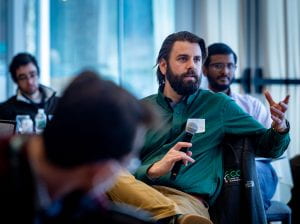
Dr. Fred Kolling presented an overview on the Single Cell Genomics Core, which provides end-to-end single cell services. They have brought on numerous applications to enhance user experience and to expand access to single cell for clinical, translational, and epidemiological research. He discussed the various automated systems evaluated to standardize tissue processing and cell/nuclei cleanup. Key workflow steps were shown for spatial transcriptomics and the instrument supplement that was submitted to acquire the Vizgen MERSCOPE platform which will allow for single-molecule imagining, up to 500 genes per slide, requires no sequencing and is cheaper than current applications.
SARS-CoV-2 Surveillance in Northern New England- COBRE Supplement
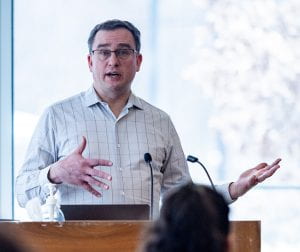
Dr. Joel A. Lefferts presented on the COBRE supplement. Significant progress has been made in helping to understand the biology of the virus by identifying variants and/or mutations. An AIM of the supplemental grant is to genome sequence ~5,000 samples. Quantitative PCR is used to ensure quality sequencing data. A total of ~3400 positive samples have been sequenced as of 4/6/2022 with many more available. The group is working to prioritize which samples to sequence, such as current cases, next wave, earlier and serial positive cases. A grant to cover year 2 of the project was submitted in March. The goals are to continue to monitor the spread, pathogenicity, and evolution of SARS-CoV-2 variants.
External Advisory Committee Meetings
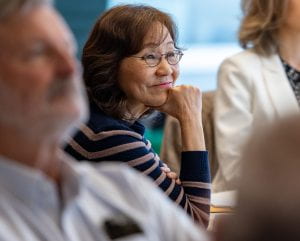

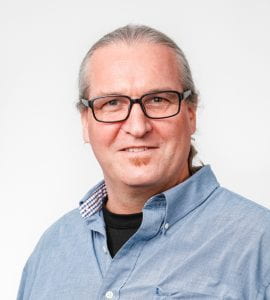
After a series of meetings with the Single Cell Genomics Core, Data Analytics Core, and our Junior Investigators, the External Advisory Committee members; Dr. Kelley Thomas, University of New Hampshire, Dr. Cathy Wu, University of Delaware, and Dr. Paul Robson, Jackson Laboratory, brought the day to a close by sharing their overall program evaluation with CQB leadership and discussing plans for the future.
